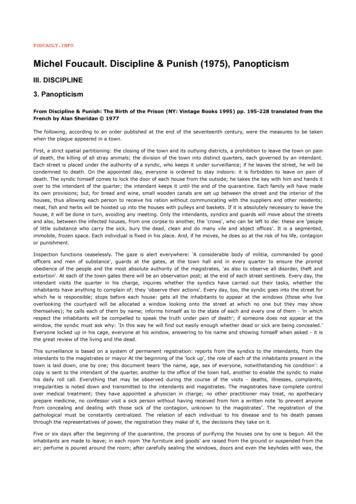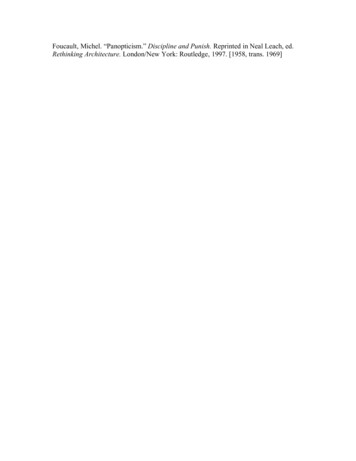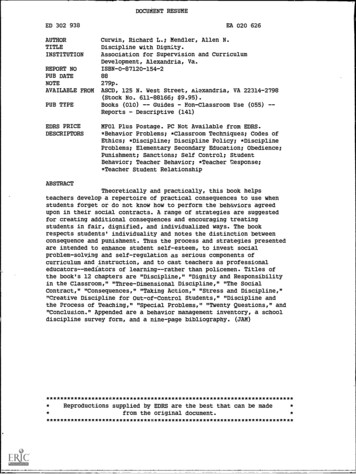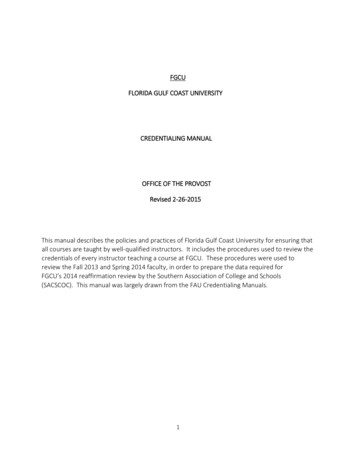
Transcription
FOUCAULT.INFOMichel Foucault. Discipline & Punish (1975), PanopticismIII. DISCIPLINE3. PanopticismFrom Discipline & Punish: The Birth of the Prison (NY: Vintage Books 1995) pp. 195-228 translated from theFrench by Alan Sheridan 1977The following, according to an order published at the end of the seventeenth century, were the measures to be takenwhen the plague appeared in a town.First, a strict spatial partitioning: the closing of the town and its outlying districts, a prohibition to leave the town on painof death, the killing of all stray animals; the division of the town into distinct quarters, each governed by an intendant.Each street is placed under the authority of a syndic, who keeps it under surveillance; if he leaves the street, he will becondemned to death. On the appointed day, everyone is ordered to stay indoors: it is forbidden to leave on pain ofdeath. The syndic himself comes to lock the door of each house from the outside; he takes the key with him and hands itover to the intendant of the quarter; the intendant keeps it until the end of the quarantine. Each family will have madeits own provisions; but, for bread and wine, small wooden canals are set up between the street and the interior of thehouses, thus allowing each person to receive his ration without communicating with the suppliers and other residents;meat, fish and herbs will be hoisted up into the houses with pulleys and baskets. If it is absolutely necessary to leave thehouse, it will be done in turn, avoiding any meeting. Only the intendants, syndics and guards will move about the streetsand also, between the infected houses, from one corpse to another, the 'crows', who can be left to die: these are 'peopleof little substance who carry the sick, bury the dead, clean and do many vile and abject offices'. It is a segmented,immobile, frozen space. Each individual is fixed in his place. And, if he moves, he does so at the risk of his life, contagionor punishment.Inspection functions ceaselessly. The gaze is alert everywhere: 'A considerable body of militia, commanded by goodofficers and men of substance', guards at the gates, at the town hall and in every quarter to ensure the promptobedience of the people and the most absolute authority of the magistrates, 'as also to observe all disorder, theft andextortion'. At each of the town gates there will be an observation post; at the end of each street sentinels. Every day, theintendant visits the quarter in his charge, inquires whether the syndics have carried out their tasks, whether theinhabitants have anything to complain of; they 'observe their actions'. Every day, too, the syndic goes into the street forwhich he is responsible; stops before each house: gets all the inhabitants to appear at the windows (those who liveoverlooking the courtyard will be allocated a window looking onto the street at which no one but they may showthemselves); he calls each of them by name; informs himself as to the state of each and every one of them - 'in whichrespect the inhabitants will be compelled to speak the truth under pain of death'; if someone does not appear at thewindow, the syndic must ask why: 'In this way he will find out easily enough whether dead or sick are being concealed.'Everyone locked up in his cage, everyone at his window, answering to his name and showing himself when asked - it isthe great review of the living and the dead.This surveillance is based on a system of permanent registration: reports from the syndics to the intendants, from theintendants to the magistrates or mayor At the beginning of the 'lock up', the role of each of the inhabitants present in thetown is laid down, one by one; this document bears 'the name, age, sex of everyone, notwithstanding his condition': acopy is sent to the intendant of the quarter, another to the office of the town hall, another to enable the syndic to makehis daily roll call. Everything that may be observed during the course of the visits - deaths, illnesses, complaints,irregularities is noted down and transmitted to the intendants and magistrates. The magistrates have complete controlover medical treatment; they have appointed a physician in charge; no other practitioner may treat, no apothecaryprepare medicine, no confessor visit a sick person without having received from him a written note 'to prevent anyonefrom concealing and dealing with those sick of the contagion, unknown to the magistrates'. The registration of thepathological must be constantly centralized. The relation of each individual to his disease and to his death passesthrough the representatives of power, the registration they make of it, the decisions they take on it.Five or six days after the beginning of the quarantine, the process of purifying the houses one by one is begun. All theinhabitants are made to leave; in each room 'the furniture and goods' are raised from the ground or suspended from theair; perfume is poured around the room; after carefully sealing the windows, doors and even the keyholes with wax, the
perfume is set alight. Finally, the entire house is closed while the perfume is consumed; those who have carried out thework are searched, as they were on entry, 'in the presence of the residents of the house, to see that they did not havesomething on their persons as they left that they did not have on entering'. Four hours later, the residents are allowed tore-enter their homes.This enclosed, segmented space, observed at every point, in l which the individuals are inserted in a fixed place, in whichthe slightest movements are supervised, in which all events are recorded, in which an uninterrupted work of writing linksthe centre and periphery, in which power is exercised without division, according to a continuous hierarchical figure, inwhich each individual is constantly located, examined and distributed among the living beings, the sick and the dead - allthis constitutes a compact model of the disciplinary mechanism. The plague is met by order; its function is to sort outevery possible confusion: that of the disease, which is transmitted when bodies are mixed together; that of the evil,which is increased when fear and death overcome prohibitions. It lays down for each individual his place, his body, hisdisease and his death, his well-being, by means of an omnipresent and omniscient power that subdivides itself in aregular, uninterrupted way even to the ultimate determination of the individual, of what characterizes him, of whatbelongs to him, of what happens to him. Against the plague, which is a mixture, discipline brings into play its power,which is one of analysis. A whole literary fiction of the festival grew up around the plague: suspended laws, liftedprohibitions, the frenzy of passing time, bodies mingling together without respect, individuals unmasked, abandoningtheir statutory identity and the figure under which they had been recognized, allowing a quite different truth to appear.But there was also a political dream of the plague, which was exactly its reverse: not the collective festival, ''but strictdivisions; not laws transgressed, but the penetration of regulation into even the smallest details of everyday life throughthe mediation of the complete hierarchy that assured the capillary functioning of power; not masks that were put on andtaken off, but the assignment to each individual of his 'true' name, his 'true' place, his 'true' body, his 'true' disease. Theplague as a form, at once real and imaginary, of disorder had as its medical and political correlative discipline. Behind thedisciplinary mechanisms can be read the haunting memory of 'contagions', of the plague, of rebellions, crimes,vagabondage, desertions, people who appear and disappear, live and die in disorder.If it is true that the leper gave rise to rituals of exclusion, which to a certain extent provided the model for and generalform of the great Confinement, then the plague gave rise to disciplinary projects. Rather than the massive, binarydivision between one set of people and another, it called for multiple separations, individualizing distributions, anorganization in depth of surveillance and control, an intensification and a ramification of power. The leper was caught upin a practice of rejection, of exile-enclosure; he was left to his doom in a mass among which it was useless todifferentiate; those sick of the plague were caught up in a meticulous tactical partitioning in which individualdifferentiations were the constricting effects of a power that multiplied, articulated and subdivided itself; the greatconfinement on the one hand; the correct training on the other. The leper and his separation; the plague and itssegmentations. The first is marked; the second analysed and distributed. The exile of the leper and the arrest of theplague do not bring with them the same political dream. The first is that of a pure community, the second that of adisciplined society. Two ways of exercising power over men, of controlling their relations, of separating out theirdangerous mixtures. The plague-stricken town, traversed throughout with hierarchy, surveillance, observation, writing;the town immobilized by the functioning of an extensive power that bears in a distinct way over all individual bodies this is the utopia of the perfectly governed city. The plague (envisaged as a possibility at least) is the trial in the courseof which one may define ideally the exercise of disciplinary power. In order to make rights and laws function according topure theory, the jurists place themselves in imagination in the state of nature; in order to see perfect disciplinesfunctioning, rulers dreamt of the state of plague. Underlying disciplinary projects the image of the plague stands for allforms of confusion and disorder; just as the image of the leper, cut off from all human contact, underlies projects ofexclusion.They are different projects, then, but not incompatible ones. We see them coming slowly together, and it is thepeculiarity of the nineteenth century that it applied to the space of exclusion of which the leper was the symbolicinhabitant (beggars, vagabonds, madmen and the disorderly formed the real population) the technique of power properto disciplinary partitioning. Treat 'lepers' as 'plague victims', project the subtle segmentations of discipline onto theconfused space of internment, combine it with the methods of analytical distribution proper to power, individualize theexcluded, but use procedures of individualization to mark exclusion - this is what was operated regularly by disciplinarypower from the beginning of the nineteenth century in the psychiatric asylum, the penitentiary, the reformatory, theapproved school and, to some extent, the hospital. Generally speaking, all the authorities exercising individual controlfunction according to a double mode; that of binary division and branding (mad/sane; dangerous/harmless;normal/abnormal); and that of coercive assignment of differential distribution (who he is; where he must be; how he isto be characterized; how he is to be recognized; how a constant surveillance is to be exercised over him in an individualway, etc.). On the one hand, the lepers are treated as plague victims; the tactics of individualizing disciplines areimposed on the excluded; and, on the other hand, the universality of disciplinary controls makes it possible to brand the'leper' and to bring into play against him the dualistic mechanisms of exclusion. The constant division between thenormal and the abnormal, to which every individual is subjected, brings us back to our own time, by applying the binary
branding and exile of the leper to quite different objects; the existence of a whole set of techniques and institutions formeasuring, supervising and correcting the abnormal brings into play the disciplinary mechanisms to which the fear of theplague gave rise. All the mechanisms of power which, even today, are disposed around the abnormal individual, to brandhim and to alter him, are composed of those two forms from which they distantly derive.Bentham's Panopticon is the architectural figure of this composition. We know the principle on which it was based: at theperiphery, an annular building; at the centre, a tower; this tower is pierced with wide windows that open onto the innerside of the ring; the peripheric building is divided into cells, each of which extends the whole width of the building; theyhave two windows, one on the inside, corresponding to the windows of the tower; the other, on the outside, allows thelight to cross the cell from one end to the other. All that is needed, then, is to place a supervisor in a central tower and toshut up in each cell a madman, a patient, a condemned man, a worker or a schoolboy. By the effect of backlighting, onecan observe from the tower, standing out precisely against the light, the small captive shadows in the cells of theperiphery. They are like so many cages, so many small theatres, in which each actor is alone, perfectly individualized andconstantly visible. The panoptic mechanism arranges spatial unities that make it possible to see constantly and torecognize immediately. In short, it reverses the principle of the dungeon; or rather of its three functions - to enclose, todeprive of light and to hide - it preserves only the first and eliminates the other two. Full lighting and the eye of asupervisor capture better than darkness, which ultimately protected. Visibility is a trap.To begin with, this made it possible - as a negative effect - to avoid those compact, swarming, howling masses that wereto be found in places of confinement, those painted by Goya or described by Howard. Each individual, in his place, issecurely confined to a cell from which he is seen from the front by the supervisor; but the side walls prevent him fromcoming into contact with his companions. He is seen, but he does not see; he is the object of information, never asubject in communication. The arrangement of his room, opposite the central tower, imposes on him an axial visibility;but the divisions of the ring, those separated cells, imply a lateral invisibility. And this invisibility is a guarantee of order.If the inmates are convicts, there is no danger of a plot, an attempt at collective escape, the planning of new crimes forthe future, bad reciprocal influences; if they are patients, there is no danger of contagion; if they are madmen there isno risk of their committing violence upon one another; if they are schoolchildren, there is no copying, no noise, nochatter, no waste of time; if they are workers, there are no disorders, no theft, no coalitions, none of those distractionsthat slow down the rate of work, make it less perfect or cause accidents. The crowd, a compact mass, a locus of multipleexchanges, individualities merging together, a collective effect, is abolished and replaced by a collection of separatedindividualities. From the point of view of the guardian, it is replaced by a multiplicity that can be numbered andsupervised; from the point of view of the inmates, by a sequestered and observed solitude (Bentham, 60-64).Hence the major effect of the Panopticon: to induce in the inmate a state of conscious and permanent visibility thatassures the automatic functioning of power. So to arrange things that the surveillance is permanent in its effects, even ifit is discontinuous in its action; that the perfection of power should tend to render its actual exercise unnecessary; thatthis architectural apparatus should be a machine for creating and sustaining a power relation independent of the personwho exercises it; in short, that the inmates should be caught up in a power situation of which they are themselves thebearers. To achieve this, it is at once too much and too little that the prisoner should be constantly observed by aninspector: too little, for what matters is that he knows himself to be observed; too much, because he has no need in fact
of being so. In view of this, Bentham laid down the principle that power should be visible and unverifiable. Visible: theinmate will constantly have before his eyes the tall outline of the central tower from which he is spied upon. Unverifiable:the inmate must never know whether he is being looked at at any one moment; but he must be sure that he may alwaysbe so. In order to make the presence or absence of the inspector unverifiable, so that the prisoners, in their cells, cannoteven see a shadow, Bentham envisaged not only venetian blinds on the windows of the central observation hall, but, onthe inside, partitions that intersected the hall at right angles and, in order to pass from one quarter to the other, notdoors but zig-zag openings; for the slightest noise, a gleam of light, a brightness in a half-opened door would betray thepresence of the guardian. The Panopticon is a machine for dissociating the see/being seen dyad: in the peripheric ring,one is totally seen, without ever seeing; in the central tower, one sees everything without ever being seen.It is an important mechanism, for it automatizes and disindividualizes power. Power has its principle not so much in aperson as in a certain concerted distribution of bodies, surfaces, lights, gazes; in an arrangement whose internalmechanisms produce the relation in which individuals are caught up. The ceremonies, the rituals, the marks by which thesovereign's surplus power was manifested are useless. There is a machinery that assures dissymmetry, disequilibrium,difference. Consequently, it does not matter who exercises power. Any individual, taken almost at random, can operatethe machine: in the absence of the director, his family, his friends, his visitors, even his servants (Bentham, 45).Similarly, it does not matter what motive animates him: the curiosity of the indiscreet, the malice of a child, the thirst forknowledge of a philosopher who wishes to visit this museum of human nature, or the perversity of those who takepleasure in spying and punishing. The more numerous those anonymous and temporary observers are, the greater therisk for the inmate of being surprised and the greater his anxious awareness of being observed. The Panopticon is amarvellous machine which, whatever use one may wish to put it to, produces homogeneous effects of power.A real subjection is born mechanically from a fictitious relation. So it is not necessary to use force to constrain theconvict to good behaviour, the madman to calm, the worker to work, the schoolboy to application, the patient to theobservation of the regulations. Bentham was surprised that panoptic institutions could be so light: there were no morebars, no more chains, no more heavy locks; all that was needed was that the separations should be clear and theopenings well arranged. The heaviness of the old 'houses of security', with their fortress-like architecture, could bereplaced by the simple, economic geometry of a 'house of certainty'. The efficiency of power, its constraining force have,in a sense, passed over to the other side - to the side of its surface of application. He who is subjected to a field ofvisibility, and who knows it, assumes responsibility for the constraints of power; he makes them play spontaneously uponhimself; he inscribes in himself the power relation in which he simultaneously plays both roles; he becomes the principleof his own subjection. By this very fact, the external power may throw off its physical weight; it tends to thenon-corporal; and, the more it approaches this limit, the more constant, profound and permanent are its effects: it is aperpetual victory that avoids any physical confrontation and which is always decided in advance.Bentham does not say whether he was inspired, in his project, by Le Vaux's menagerie at Versailles: the first menageriein which the different elements are not, as they traditionally were, distributed in a park (Loisel, 104-7). At the centre wasan octagonal pavilion which, on the first floor, consisted of only a single room, the king's salon; on every side largewindows looked out onto seven cages (the eighth side was reserved for the entrance), containing different species ofanimals. By Bentham's time, this menagerie had disappeared. But one finds in the programme of the Panopticon asimilar concern with individualizing observation, with characterization and classification, with the analytical arrangementof space. The Panopticon is a royal menagerie; the animal is replaced by man,, individual distribution by specific
grouping and the king by the machinery of a furtive power. With this exception, the Panopticon also does the work of anaturalist. It makes it possible to draw up differences: among patients, to observe the symptoms of each individual,without the proximity of beds, the circulation of miasmas, the effects of contagion confusing the clinical tables; amongschool-children, it makes it possible to observe performances (without there being any imitation or copying), to mapaptitudes, to assess characters, to draw up rigorous classifications and, in relation to normal development, to distinguish'laziness and stubbornness' from 'incurable imbecility'; among workers, it makes it possible to note the aptitudes of eachworker, compare the time he takes to perform a task, and if they are paid by the day, to calculate their wages (Bentham,60-64).So much for the question of observation. But the Panopticon was also a laboratory; it could be used as a machine tocarry out experiments, to alter behaviour, to train or correct individuals. To experiment with medicines and monitor theireffects. To try out different punishments on prisoners, according to their crimes and character, and to seek the mosteffective ones. To teach different techniques simultaneously to the workers, to decide which is the best. To try outpedagogical experiments - and in particular to take up once again the well-debated problem of secluded education, byusing orphans. One would see what would happen when, in their sixteenth or eighteenth year, they were presented withother boys or girls; one could verify whether, as Helvetius thought, anyone could learn anything; one would follow 'thegenealogy of every observable idea'; one could bring up different children according to different systems of thought,making certain children believe that two and two do not make four or that the moon is a cheese, then put them togetherwhen they are twenty or twenty-five years old; one would then have discussions that would be worth a great deal morethan the sermons or lectures on which so much money is spent; one would have at least an opportunity of makingdiscoveries in the domain of metaphysics. The Panopticon is a privileged place for experiments on men, and for analysingwith complete certainty the transformations that may be obtained from them. The Panopticon may even provide anapparatus for supervising its own mechanisms. In this central tower, the director may spy on all the employees that hehas under his orders: nurses, doctors, foremen, teachers, warders; he will be able to judge them continuously, alter theirbehaviour, impose upon them the methods he thinks best; and it will even be possible to observe the director himself. Aninspector arriving unexpectedly at the centre of the Panopticon will be able to judge at a glance, without anything beingconcealed from him, how the entire establishment is functioning. And, in any case, enclosed as he is in the middle of thisarchitectural mechanism, is not the - 5 director's own fate entirely bound up with it ? The incompetent physician who hasallowed contagion to spread, the incompetent prison governor or workshop manager will be the first victims of anepidemic or a revolt. ' "By every tie I could devise", said the master of the Panopticon, "my own fate had been bound upby me with theirs"' (Bentham, 177). The Panopticon functions as a kind of laboratory of power. Thanks to its mechanismsof observation, it gains in efficiency and in the ability to penetrate into men's behaviour; knowledge follows the advancesof power, discovering new objects of knowledge over all the surfaces on which power is exercised.The plague-stricken town, the panoptic establishment - the differences are important. They mark, at a distance of acentury and a half, the transformations of the disciplinary programme. In the first case, there is an exceptional situation:against an extraordinary evil, power is mobilized; it makes itself everywhere present and visible; it invents newmechanisms; it separates, it immobilizes, it partitions constructs for a time what is both a counter-city and the perfectsociety; it imposes an ideal functioning, but one that is reduced, in the final analysis, like the evil that it combats, to asimple dualism of life and death: that which moves brings death, and one kills that which moves. The Panopticon, on theother hand, must be understood as a generalizable model of functioning; a way of defining power relations in terms ofthe everyday life of men. No doubt Bentham presents it as a particular institution, closed in upon itself. Utopias, perfectlyclosed in upon themselves, are common enough. As opposed to the ruined prisons, littered with mechanisms of torture,to be seen in Piranese's engravings, the Panopticon presents a cruel, ingenious cage. The fact that it should have givenrise, even in our own time, to so many variations, projected or realized, is evidence of the imaginary intensity that it haspossessed for almost two hundred years. But the Panopticon must not be understood as a dream building: it is thediagram of a mechanism of l power reduced to its ideal form; its functioning, abstracted from any obstacle, resistance orfriction, must be represented as a pure architectural and optical system: it is in fact a figure of political technology thatmay and must be detached from any specific use.It is polyvalent in its applications; it serves to reform prisoners, but also to treat patients, to instruct schoolchildren, toconfine the insane, to supervise workers, to put beggars and idlers to work. It is a type of location of bodies in space, ofdistribution of individuals in relation to one another, of hierarchical organization, of disposition of centres and channels ofpower, of definition of the instruments and modes of intervention of power, which can be implemented in hospitals,workshops, schools, prisons. Whenever one is dealing with a multiplicity of individuals on whom a task or a particularform of behaviour must be imposed, the panoptic schema may be used. It is - necessary modifications apart - applicable'to all establishments whatsoever, in which, within a space not too large to be covered or commanded by buildings, anumber of persons are meant to be kept under inspection' (Bentham, 40; although Bentham takes the penitentiaryhouse as his prime example, it is because it has many different functions to fulfil - safe custody, confinement, solitude,forced labour and instruction).
In each of its applications, it makes it possible to perfect the exercise of power. It does this in several ways: because itcan reduce the number of those who exercise it, while increasing the number of those on whom it is exercised. Becauseit is possible to intervene at any moment and because the constant pressure acts even before the offences, mistakes orcrimes have been committed. Because, in these conditions, its strength is that it never intervenes, it is exercisedspontaneously and without noise, it constitutes a mechanism whose effects follow from one another. Because, withoutany physical instrument other than architecture and geometry, it acts directly on individuals; it gives 'power of mind overmind'. The panoptic schema makes any apparatus of power more intense: it assures its economy (in material, inpersonnel, in time); it assures its efficacity by its preventative character, its continuous functioning and its automaticmechanisms. It is a way of obtaining from power 'in hitherto unexampled quantity', 'a great and new instrument ofgovernment . . .; its great excellence consists in the great strength it is capable of giving to any institution it may bethought proper to apply it to' (Bentham, 66).It's a case of 'it's easy once you've thought of it' in the political sphere. It can in fact be integrated into any function(education, medical treatment, production, punishment); it can increase the effect of this function, by being linkedclosely with it; it can constitute a mixed mechanism in which relations of power (and of knowledge) may be preciselyadjusted, in the smallest detail, to the processes that are to be supervised; it can establish a direct proportion between'surplus power' and 'surplus production'. In short, it arranges things in such a way that the exercise of power is notadded on from the outside, like a rigid, heavy constraint, to the functions it invests, but is so subtly present in them as toincrease their efficiency by itself increasing its own points of contact. The panoptic mechanism is not simply a hinge, apoint of exchange between a mechanism of power and a function; it is a way of making power relations function in afunction, and of making a function function through these power relations. Bentham's Preface to Panopticon opens with alist of the benefits to be obtained from his 'inspection-house': 'Morals reformed - health preserved - industry invigorated- instruction diffused -public burthens lightened - Economy seated, as it were, upon a rock - the gordian knot of thePoor-Laws not cut, but untied - all by a simple idea in architecture!' (Bentham, 39)Furthermore, the arrangement of this machine is such that its enclosed nature does not preclude a permanent presencefrom the outside: we have seen that anyone may come and exercise in the central tower the functions of surveillance,and that, this being the case, he can gain a clear idea of the
plague as a form, at once real and imaginary, of disorder had as its medical and political correlative discipline. Behind the disciplinary mechanisms can be read the haunting memory of 'contagions', of the plague, of rebellions, crimes, vagabondage, desertions, p










